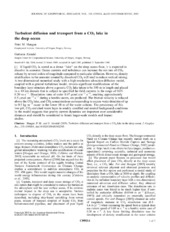Turbulent diffusion and transport from a CO2 lake in the deep ocean
Journal article
Permanent lenke
https://hdl.handle.net/1956/807Utgivelsesdato
2005-09-21Metadata
Vis full innførselSamlinger
- Geophysical Institute [1228]
Originalversjon
https://doi.org/10.1029/2004jc002583Sammendrag
If liquid CO2 is stored as a dense ‘‘lake’’ on the deep ocean floor, it is expected to dissolve in seawater. Ocean currents and turbulence can increase the net rate of CO2 release by several orders of magnitude compared to molecular diffusion. However, density stratification in the seawater created by dissolved CO2 will tend to reduce vertical mixing. A two-dimensional numerical study with a high-resolution advection-diffusion model, coupled with a general turbulence model, reveals significant modifications of the boundary layer structure above a generic CO2 lake taken to be 500 m in length and placed in a 10 km domain that is subject to specified far-field currents in the range of 0.05–0.20 m s-1. Dissolution rates of order 0.07 μmol cm-2 s-1, reaching approximately 0.5 μmol cm-2 s-1 during a benthic storm, are predicted. The friction velocity is reduced above the CO2 lake, and CO2 concentrations corresponding to excess water densities of up to 0.5 kg m-3 occur in the lower 10 m of the water column. The persistency of this low-pH, CO2-enriched water layer in weakly stratified and neutral background conditions in the model suggests that gravity current dynamics are important over considerable distances and should be considered in future larger-scale models and impact studies.
